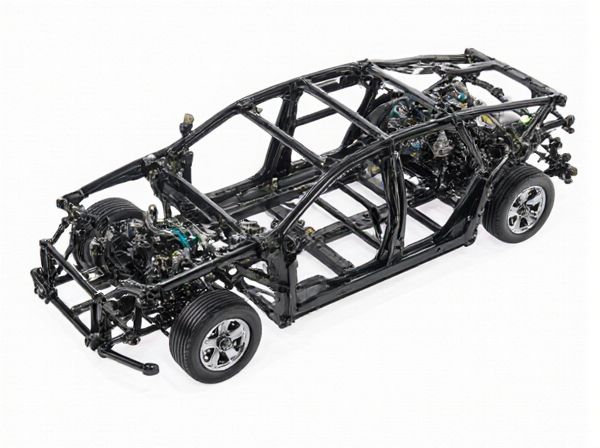
Photo illustration: Box Frame vs C-Channel Frame
Box frames provide superior rigidity and resistance to twisting due to their enclosed rectangular shape, making them ideal for heavy-duty applications. C-channel frames, with their open C-shaped cross-section, offer easier access for mounting and welding but are less torsionally stiff. Choosing the right frame depends on your specific load requirements and structural demands.
Table of Comparison
| Feature | Box Frame | C-Channel Frame |
|---|---|---|
| Structure | Closed rectangular steel tubes | Open C-shaped steel sections |
| Strength | High torsional rigidity and strength | Lower torsional strength, prone to twisting |
| Weight | Heavier due to enclosed design | Lighter, simpler construction |
| Durability | Better resistance to bending and impact | Less impact resistance, can deform under stress |
| Cost | More expensive, complex manufacturing | Cost-effective, easier to produce |
| Application | Used in heavy-duty and performance vehicles | Common in light trucks and older vehicles |
Introduction to Frame Types
Box frame and C-channel frame are two common structural frame types used in construction and manufacturing, each offering distinct advantages based on design requirements. Box frames consist of welded or bolted rectangular sections that provide excellent torsional rigidity and strength, ideal for heavy-duty applications and load-bearing structures. C-channel frames, characterized by their C-shaped cross-section, are lighter and easier to fabricate, making them suitable for lighter loads and applications where cost and weight efficiency are priorities.
What Is a Box Frame?
A box frame consists of rectangular or square steel tubes welded together to create a strong, rigid structure commonly used in automotive and industrial applications. This design offers superior torsional rigidity and impact resistance compared to C-channel frames, making it ideal for heavy-duty or high-performance requirements. Its enclosed shape effectively distributes stresses and reduces the likelihood of twisting or bending under load.
What Is a C-Channel Frame?
A C-channel frame is a structural component shaped like the letter "C," widely used in construction and manufacturing for its high strength-to-weight ratio and ease of assembly. Its open-sided design allows for simple integration with other materials, offering excellent support for horizontal loads and resistance to bending. Compared to box frames, C-channel frames provide easier access for wiring and plumbing while maintaining durability in framing applications.
Structural Strength Comparison
Box frames provide superior torsional rigidity and resistance to bending due to their enclosed geometry, distributing loads evenly across all sides. C-channel frames, with an open cross-section, tend to concentrate stress along the edges, making them more vulnerable to twisting and deformation under heavy loads. Structural strength comparisons show box frames are ideal for applications demanding high load capacity and durability, while C-channel frames offer lighter weight but reduced stiffness.
Weight and Material Efficiency
Box frames, typically made from rectangular or square hollow sections, offer superior torsional rigidity while often weighing more due to their closed cross-section design. C-channel frames are lighter and simpler, using open cross-sections that provide efficient use of material for bending loads but may require reinforcement to improve torsional stiffness. Material efficiency in box frames stems from uniform stress distribution in enclosed profiles, whereas C-channels optimize weight by concentrating material where bending stresses are highest.
Cost Considerations
Box frames typically offer higher structural strength and durability but come with increased material and fabrication costs compared to C-channel frames. C-channel frames are more cost-efficient due to simpler manufacturing processes and lower material usage, making them suitable for budget-conscious projects with moderate load requirements. Selecting between the two depends on balancing budget constraints with performance needs and long-term maintenance expenses.
Applications and Use Cases
Box frames offer superior rigidity and torsional strength, making them ideal for heavy-duty applications such as truck beds, trailers, and industrial machinery supports where load distribution and durability are critical. C-channel frames are commonly used in lighter structural applications like equipment racks, vehicle chassis, and structural supports where ease of fabrication and weight considerations are prioritized. Both frame types serve distinct roles in construction and manufacturing, chosen based on specific load requirements and environmental conditions.
Durability and Maintenance
Box frames offer superior durability due to their enclosed structure, which resists twisting and bending under heavy loads more effectively than C-channel frames. The enclosed design also reduces exposure to environmental elements, resulting in lower maintenance requirements and less susceptibility to rust and corrosion. In contrast, C-channel frames, with their open cross-section, may require more frequent inspections and maintenance to prevent structural degradation over time.
Installation and Assembly Differences
Box frames offer a closed structural design providing enhanced rigidity, which simplifies alignment during installation and reduces the need for additional bracing. C-channel frames feature an open profile that allows easier access for bolting and welding, facilitating quicker assembly in tight or complex spaces. However, C-channel frames may require extra components or support to maintain stability, impacting overall installation time compared to the more self-supporting box frame design.
Choosing the Right Frame for Your Project
Choosing between a box frame and a C-channel frame depends on the structural requirements and application of your project. Box frames offer superior torsional rigidity and strength, making them ideal for heavy-duty or high-stress environments such as automotive chassis and industrial machinery. C-channel frames are lighter and easier to work with, suitable for lighter loads or applications requiring frequent assembly and disassembly, such as shelving or lightweight frameworks.
 caratoz.com
caratoz.com